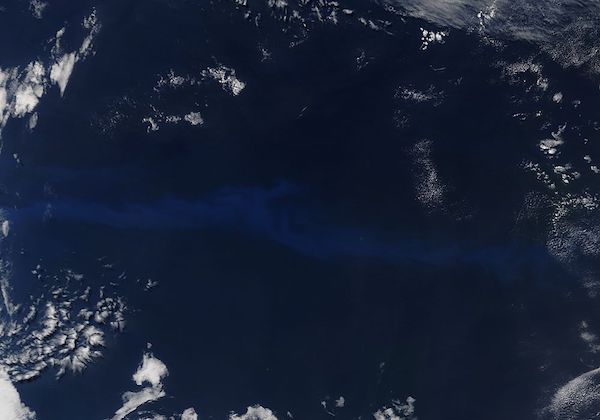Images
November 29, 2017 - Phytoplankton bloom in the South Atlantic Ocean
Tweet
A broad band of milky-blue and dull, swirling patches of green colored the far reaches of the Southern Atlantic Ocean in late November, 2017. The Moderate Resolution Imaging Spectroradiometer (MODIS) aboard NASA’s Aqua satellite captured a true-color image of the scene on November 25.
The image is centered on a remote piece of the Southern Atlantic Ocean located roughly 1,800 miles (2,900 km) from the closest point of South America, 1,200 mi (1,900 km) from the tip of Africa, and 2,000 mi (3,500 km) from Antarctica. Sitting at 45° south latitude and 8.4 ° west longitude, the area is in the center of the “roaring forties”, where strong prevailing westerly winds whip across the expansive open ocean relatively unimpeded by any substantial land mass. Just to the south, the gale-force winds increase in the “furious fifties”.
At the same times as the winds almost unceasingly whip the ocean surface in these southerly latitudes, strong currents are also on the move in the deep ocean waters. It is here, approximately between 40° and 60° south latitude, that northern, warmer, subtropical waters converge with the more frigid Antarctic waters. Strong westerly currents and dynamic mixing of thermally diverse waters combine to form marked temperature gradients as well as robust upwelling of deep water which is rich in nutrients. Where the nutrient-rich water rises into the sunlit upper ocean layers, microscopic, plant-like organisms called phytoplankton thrive, bursting into explosive, massive blooms when conditions are favorable.
Phytoplankton form the base of the Antarctic food web. The more than 300 species of phytoplankton identified in Antarctic waters help sustain a rich diversity of ocean life – including krill, seals, whales, dolphin, penguins, seabirds and a wide variety of fish. Phytoplankton also play a critical role in biogeochemical cycles that mediate global climate. One important role is the sequestration of carbon that occurs when the dying organisms, rich in carbon, fall to the bottom of the ocean and are sequestered there. According to a number of studies published between 1999 and 2015, the world’s oceans have taken up between 25 and 30% of the anthropogenic carbon dioxide released to the atmosphere, with about 40% of this uptake occurring in the Southern Ocean.
Image Facts
Satellite:
Terra
Date Acquired: 11/25/2017
Resolutions:
1km (69.4 KB), 500m (219.4 KB), 250m (539.4 KB)
Bands Used: 1,4,3
Image Credit:
Jeff Schmaltz, MODIS Land Rapid Response Team, NASA GSFC
Tweet
A broad band of milky-blue and dull, swirling patches of green colored the far reaches of the Southern Atlantic Ocean in late November, 2017. The Moderate Resolution Imaging Spectroradiometer (MODIS) aboard NASA’s Aqua satellite captured a true-color image of the scene on November 25.
The image is centered on a remote piece of the Southern Atlantic Ocean located roughly 1,800 miles (2,900 km) from the closest point of South America, 1,200 mi (1,900 km) from the tip of Africa, and 2,000 mi (3,500 km) from Antarctica. Sitting at 45° south latitude and 8.4 ° west longitude, the area is in the center of the “roaring forties”, where strong prevailing westerly winds whip across the expansive open ocean relatively unimpeded by any substantial land mass. Just to the south, the gale-force winds increase in the “furious fifties”.
At the same times as the winds almost unceasingly whip the ocean surface in these southerly latitudes, strong currents are also on the move in the deep ocean waters. It is here, approximately between 40° and 60° south latitude, that northern, warmer, subtropical waters converge with the more frigid Antarctic waters. Strong westerly currents and dynamic mixing of thermally diverse waters combine to form marked temperature gradients as well as robust upwelling of deep water which is rich in nutrients. Where the nutrient-rich water rises into the sunlit upper ocean layers, microscopic, plant-like organisms called phytoplankton thrive, bursting into explosive, massive blooms when conditions are favorable.
Phytoplankton form the base of the Antarctic food web. The more than 300 species of phytoplankton identified in Antarctic waters help sustain a rich diversity of ocean life – including krill, seals, whales, dolphin, penguins, seabirds and a wide variety of fish. Phytoplankton also play a critical role in biogeochemical cycles that mediate global climate. One important role is the sequestration of carbon that occurs when the dying organisms, rich in carbon, fall to the bottom of the ocean and are sequestered there. According to a number of studies published between 1999 and 2015, the world’s oceans have taken up between 25 and 30% of the anthropogenic carbon dioxide released to the atmosphere, with about 40% of this uptake occurring in the Southern Ocean.
Image Facts
Satellite:
Terra
Date Acquired: 11/25/2017
Resolutions:
1km (69.4 KB), 500m (219.4 KB), 250m (539.4 KB)
Bands Used: 1,4,3
Image Credit:
Jeff Schmaltz, MODIS Land Rapid Response Team, NASA GSFC




